Abstract
Burrowing crabs are considered to be ecosystem engineers, playing a vital role in mangrove ecosystems through bio-geochemical transformation. This process depends on the size and shape of burrows. The present study analyzes the architecture of burrows constructed by crabs in a restored mangrove habitat. Fourteen crab species were found to construct burrows of 13 different shapes, with a predominance of I-, J-, and L-shapes. Sesarmids were larger in size than fiddlers, and made burrows with wider openings mostly in the Rhizophora zone. Fiddlers constructed complex burrows with a vertical position, and made longer and deeper burrows in contrast to sesarmids, which formed simple burrows with a horizontal position, digging shorter and shallower burrows in Avicennia or open zones. The sesarmids had smaller burrows without branching in mangrove zones, whereas the fiddlers had larger burrows with or without branching in open and Avicennia zones. The burrows of fiddler crabs, especially Austruca occidentalis and A. annulipes, had separate openings and passages for exit and entry as an adaptation against predators. The present work identified Austruca occidentalis and A. annulipes as the most potent bioturbating crab species in restored mangrove habitats due to their efficiency in soil excavation and formation of large-sized burrows.
1. Introduction
Crabs are a keystone species in mangrove forest ecosystems (Smith et al., 1991) and are actively involved in burrowing, during which sediments are excavated and mixed that can alter the physical, chemical and biological aspects. This process is known as bioturbation. This activity aerates sediment, flushes soil, reduces pore-water salinity, increases nutrient availability, reduces toxic sulfide levels and creates microhabitats for benthic organisms [1,2,3]. The bioturbating crabs are considered to be ecosystem engineers in mangrove ecosystems because they have considerable impact on ecosystem functioning through bio-geochemical transformations at the water-sediment interface of mangrove habitats [3,4,5,6,7].
Crab burrow architecture is species-specific, but the crabs can modify the architecture to adjust to a wide range of conditions that prevail in different habitats. The crabs display significant inter-specific variations in their burrow morphologies in relation to different environmental and biological factors of their biotopes [8,9]. The burrows vary in shape and size, depending on biological factors such as crab species, size, sex and reproductive stages [9,10,11]. The burrow architecture is also dependent on abiotic factors, such as sediment composition, vegetation, shore elevation, tidal variation, sub-surface root system and human disturbances [7]. The burrows serve as a refuge against environmental adversity and as a shelter for food storage and reproduction [11]. This is a major bioengineering effect that alters physical and chemical processes in mangrove forests [12]. The burrow functionality varies with architecture, and is differently constructed by different crab species [13].
Burrow morphology varies between brachyuran crabs and hence the composition of burrowing crabs has the potential to impact ecosystems differently [14]. The burrow morphologies can also provide estimates of bioturbative activity by crabs from burrow volume and burrow depth [13]. Most species within the sesarmids and the fiddlers are involved in burrowing in mangrove sediments [6]. The burrow morphologies have been extensively studied in different species of fiddler crab: Uca rapax, U. pugnax, U. longisignalis, U. spinicarpa, U. vocator, U. subcylindrica, U. tangeri, U. annulipes and U. vocans [11].
Mangroves are among the most valuable ecosystems on Earth for food fish production, carbon sequestration, climate change mitigation, pollution removal, coastal protection, ecotourism and coastal livelihoods. In many parts of the world the mangroves have been lost or degraded, along with their valuable services, and the long-term survival of the mangrove ecosystem is at great risk [15]. Hence, mangrove restoration has been popular for a long time with different objectives, including planting for timber, fuelwood, and roofing materials before the year 1980, before largely diversifying into coastal protection, erosion reduction, fisheries enhancement, pollution abatement, biodiversity conservation and climate change mitigation. Continuous monitoring is made in mangrove restored sites for the purposes of maintaining the normal tidal water flow, supplementary planting, weed/pest removal, trash removal, avoiding cattle grazing and de-siltation [16]. However, the functional role of crabs, a keystone species in mangroves, is largely ignored in the restored sites.
Vegetation influences the spatial distribution, abundance and burrowing activities of crabs within mangroves [5]. The fiddler crabs construct fewer burrows on exposed beaches (non-mangroves) than under the mangrove canopy, according to food availability. However, the number of crab burrows under the mangrove canopy decreases as the canopy cover increases, and this is evident by a negative relationship between crab burrow density and mangrove canopy cover. Such studies are mostly confined to natural mangrove habitats rather than to restored mangroves [17]. At one site along the southeast coast of India, no crabs were found to be present originally, but they later became well-established after a period of mangrove restoration [18] (A. However, there is no data on the crab burrow architecture in that restored mangrove habitat, and this information is required to provide insight into the functional aspects of the crabs in the restored mangrove area. Hence, the present work was undertaken to deal with species-specific burrow excavation and architecture so as to identify the most influential functional species and also to find out the relationship between burrow characters and size of the crab species in a restored mangrove habitat.
2. Materials and Methods
2.1. Study Area
The study area is at an area of mangrove vegetation artificially raised along the northern banks of the Vellar estuary on the southeast coast of India (Lat. 11°29′ N; Long. 79°46′ E; Figure 1). The mangrove forest is about 25 years old and covers an area of about 5 hectares. It is colonized with a Rhizophora zone towards the estuary and an Avicennia zone landward, and there is a non-vegetated open zone in the upper intertidal area.
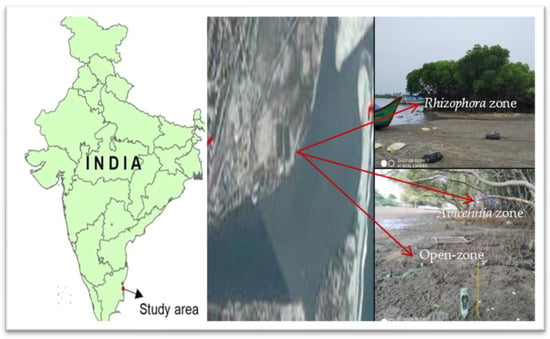
Figure 1.
Study area along a restored mangrove forest in the Vellar estuary, southeastern India.
2.2. Sampling and Analyses
Sampling was carried out in the three intertidal zones, namely, Rhizophora, Avicennia, and open zone for three seasons: monsoon (Nov. 2019), post-monsoon (Feb. 2020) and summer (June 2020). Crab burrow casts were made using plaster of Paris in randomly selected burrows from a quadrat of 1 sq. m laid in each of three intertidal zones during the period of low tide.
Crab burrow studies: Burrow casts were prepared using an aqueous solution of plaster of Paris, made in a ratio of 3:1 for plaster of Paris powder and water. This solution was poured into the crab burrows using a syringe until the burrows were completely filled [19]. After 3 h of drying, the burrow casts were carefully dug up manually, or with a spade if the substrate was hardy. The casts were cleaned and thoroughly washed to remove all debris. Each cast was measured for architecture in terms of burrow opening diameter (BOD), total burrow length (TBL), total burrow depth (TBD) and burrow shape (BS). Soil excavation activity was measured in terms of burrow volume (BV) using a water displacement method based on the Archimedes principle. The complexity of burrow architecture was calculated as the ratio between TBL and TBD.
Crab studies: The crabs which emerged out of the burrows while adding plaster of Paris were collected manually and transferred to the laboratory in polythene bags. The crabs were individually detected for sex and measured for their size in terms of body weight as well as carapace length and width using a venire caliper. The crabs were then identified based on morphological characters by following the World Register of Marine Species (WORMS).
Statistical analyses: The data was subjected to statistical analysis using SPSS.17 to test the significance between crab species for crab size or burrow architectures. Levene’s test was conducted to test for equality of variance and covariance. Since it was non-significant, further multivariate analysis was made along with post hoc and Tukey’s test to determine the significant differences for pair-wise comparison of different species. Pearson correlation coefficients were calculated flagging with significance at 1% and 5% levels at p < 0.01 and p < 0.05, respectively, to determine the relationship between measures of crabs and burrow characteristics.
3. Results
3.1. Burrow Types
The shape-based burrow types found in crab species across the intertidal zones of restored mangrove habitat under different seasons are given in Table 1. In total, 14 burrowing crab species that included fiddlers (seven species) and sesarmids (seven species) were collected from the study area. A total of 48 burrow casts were prepared and categorized into 13 types based on shape; these were J, Y, L, C, I, CS, U, LL, V, X, S, CL, and JU types (Figure 2). The burrows were predominantly ‘I’ shaped, contributing to 35.4% of total casts, followed by ‘J’ (18.8%) and ‘L’ shaped (16.7%). Other types were ‘Y’ shaped (6.3%), LL (4.2%), V (4.2%) and the remaining (‘C’, ‘CS’, ‘U’, ‘X’, ‘S’, ‘CL’ and ‘JU’ shaped) each contributed only 2.1%.

Table 1.
Burrow shape and its structural complexity ratio across three intertidal zones under three seasons of analysis in the restored mangrove forest.
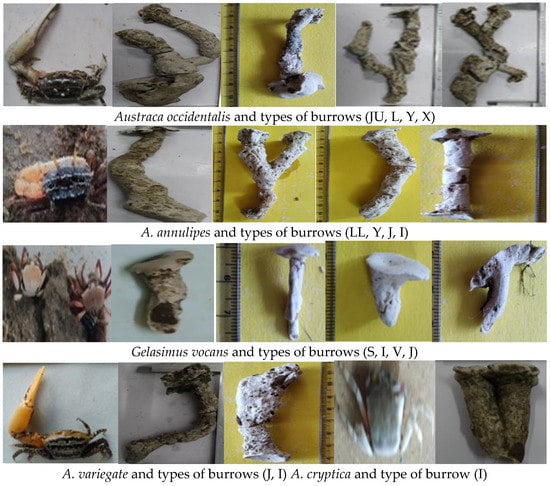
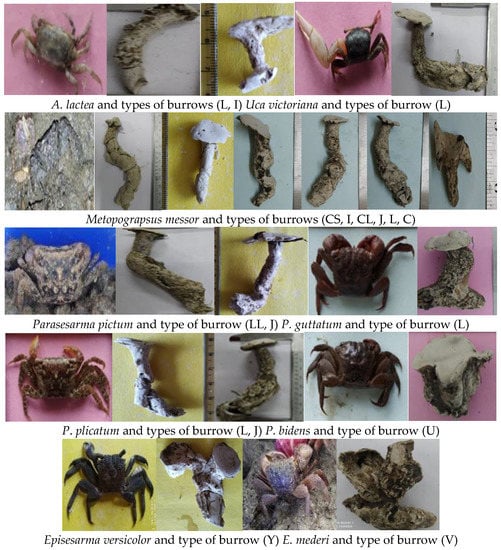
Figure 2.
Crab burrow architectures found in restored mangrove habitat.
Burrow shape varied with crab species. Metopograpsus messor displayed the maximum number of six types of burrow shape (L, I, CS, C, CL, J), followed by four types in Austruca occidentalis (L, JU, Y, X), Gelasimus vocans (I, S, J, V) and A. annulipes (I, LL, J, Y). Two types of burrows were found in A. lactea (L, I), A. variegata (I, J), Parasesarma plicatum (L, J) and P. pictum (LL, J). Only one type of burrow was found in Austruca cryptica (I), Parasesarma bidens (U), Uca victoriana (L), P. guttatum (L), Episesarma mederi (V), and E. vesicolor (Y).
Burrowing activity of crabs varied with intertidal zone and season in the restored mangrove habitat. Metopograpsus messor constructed burrows only in mangrove zones: in the Rhizophora zone during monsoon and in the Avicennia zone during post-monsoon and summer. Thus, there seemed to be a shift in the burrow construction from Rhizophora to Avicennia during monsoon to summer. Parasesarma pictum constructed burrows only in the Avicennia zone during summer and monsoon. Similarly, Austruca lactea formed burrows only in Avicennia in all three seasons, and there seemed to be a shift in the shape from I to L from monsoon to summer. Austruca variegata constructed burrows only in mangrove zones, and there was also a shift in the shape from I to J from monsoon to post-monsoon. Austruca occidentalis produced burrows only in the monsoon in both Avicennia and open zones, whereas Gelasimus vocans made burrows in Avicennia and open zones in all three seasons. Austruca annulipes produced burrows in Avicennia and open zones during monsoon and summer (Table 1).
There was a significant difference between seasons when the variables of crab size or burrow architecture were considered jointly. All variables were significant except for crab weight, carapace width, burrow opening diameter, burrow volume and burrow shape. Similarly, there was a significant difference between intertidal zones when the variables of crab size or burrow architecture were considered jointly. All variables were significant except for total burrow length, total burrow depth and burrow shape.
Burrow structural complexity was measured as the ratio between TBL and TBD. This ratio varied with burrow shape. The ratio was higher than the value of 1 for ‘V’ and ‘Y’; but less than 1 for other shapes (JU, J, I, X, LL, S, L, U, C, CS). It is interesting to note that the ratio was found to be high, i.e., exceeding the value of 1, only in summer in the Avicennia or open zones for the burrow shapes of I, J, Y, V. The ratio also varied with crab species. It ranged from 0.93 to 1.06 for fiddlers, and from 0.93 to 0.98 for sesarmids. The burrow structure was relatively complex in fiddlers such as Gelasimus vocans (1.06) and Austruca annulipes (0.99), and in sesarmids such as Parasesarma pictum (0.98), Metopograpsus messor (0.97), and P. plicatum (0.97) (Table 1).
3.2. Size of Crab Species
The crab size in terms of weight, carapace length and width for 14 species is shown in Figure 3. Crab weight varied from 0.17 to 0.36 g for fiddlers, and from 0.22 to 0.90 g for sesarmids. It was the highest in Austraca occidentalis and Episesarma versicolor, and the lowest in Gelasimus vocans and Metopograpsus messor. The crab weight was in correlation with carapace width (r = 0.95), carapace length (r = 0.93), BOD (r = 0.92), MBL (r = 0.48), TBL (r = 0.44), TBD (r = 0.44), and BV (r = 0.38).
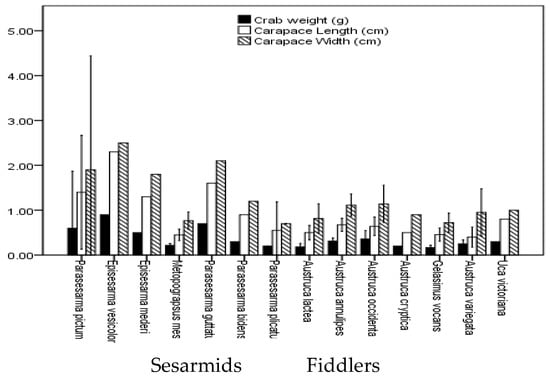
Figure 3.
Crab weight, carapace width and length in 14 burrowing crab species; values significant between crab species at 1% level.
Carapace length ranged from 0.4 to 0.8 cm for fiddlers and from 0.4 to 2.3 cm for sesarmids. It was the maximum in Uca victoriana and Episesarma vesicolor, and minimum in Austraca variegata and Parasesarma pictum (Figure 3). The carapace length was in correlation with carapace width (r = 0.93), BOD (r = 0.92), MBL (r = 0.40), TBD (r = 0.30) and TBL (r = 0.30).
Carapace width varied between 0.72 and 1.14 cm for fiddlers and from 0.7 to 2.5 cm for sesarmids, being the maximum in Austraca occidentalis and Episesarma vesicolor and the minimum in Gelasimus vocans and Parasesarma plicatum (Figure 3). The carapace width was in correlation with BOD (r = 0.99), MBL (r = 0.47), TBD (r = 0.40), TBL (r = 0.40) and BV (r = 0.32).
There was a significant difference between crab species when considered jointly on the variables of crab size or burrow architecture. However, there was no significant difference between sexes in crab size or burrow architecture, except for burrow shape.
3.3. Burrow Architecture of Crab Species
Soil excavation activity in terms of burrow volume in different crab species is shown in Figure 4. Burrow volume (BV) varied from 3.52 to 45.6 cm3 for fiddlers and from 1.95 to 24.0 cm3 for sesarmids. BV was the highest in Austruca occidentalis and Episesarma vesicolor, and the lowest in Austruca lactea and Parasesarma plicatum. The BV was in correlation with TBL (r = 0.81), TBD (r = 0.81) and burrow shape (r = 0.44) (Figure 5).
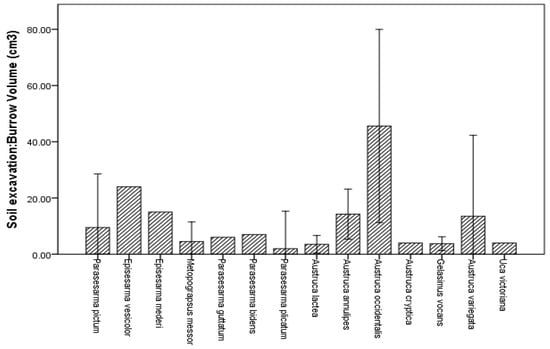
Figure 4.
Crab species-specific soil excavation activity in terms of burrow volume (cm3); values significant between crab species at 1% level.
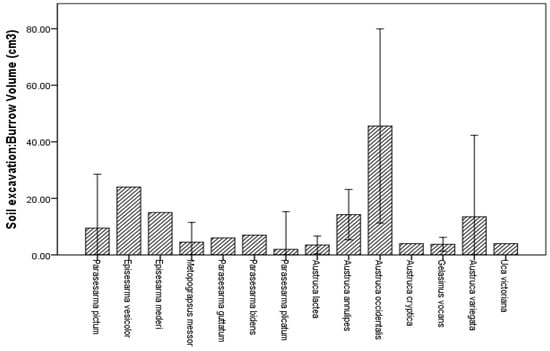
Figure 5.
Relationship between burrow volume and total burrow length (r = 0.81) and total burrow depth (r = 0.81).
Burrow measures for 14 crab species are given in Figure 6. Total burrow length (TBL) ranged from 1.3 to 12.72 cm for fiddlers, and from 2.6 to 9.75 cm for sesarmids. TBL was the highest in Austruca occidentalis and Parasesarma pictum, and the lowest in Austruca cryptica and Parasesarma plicatum. The TBL was in correlation with TBD (0.99), BV (r = 0.81), BOD (r = 0.40), burrow shape (r = 0.38), crab weight (r = 0.44), carapace width (r = 0.4) and length (r = 0.30).
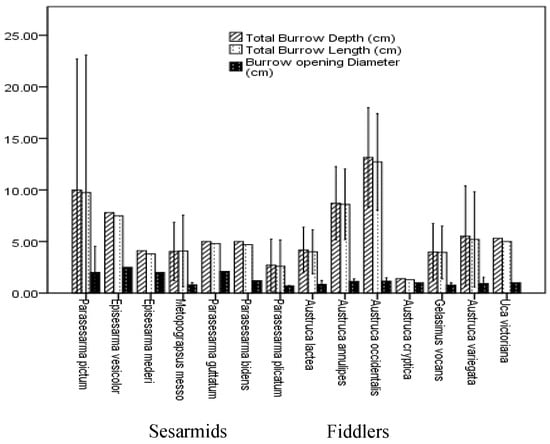
Figure 6.
Crab species-specific burrow opening diameter, length and depth of burrows; values significant between crab species at 1% level.
Total burrow depth (TBD) varied from 1.4 to 13.16 cm for fiddlers and from 2.7 to 10 cm for sesarmids. TBD was the highest in Austruca occidentalis and Parasesarma pictum and the lowest in Austruca cryptica and Parasesarma plicatum (Figure 6). The TBD was in correlation with TBL (r = 0.99), BV (r = 0.81), BOD (r = 0.39), burrow shape (r = 0.36), crab weight (r = 0.44), carapace width (r = 0.40) and carapace length (r = 0.30).
Burrow opening diameter (BOD) varied from 0.78 to 1.16 cm for fiddlers and from 0.7 to 2.5 cm for sesarmids. BOD was the maximum in Austruca occidentalis and Episesarma vesicolor, and the minimum in Gelasimus vocans and Parasesarma plicatum. The BOD was in correlation with carapace width (r = 0.99), crab weight (r = 0.92), carapace length (r = 0.92), TBL (r= 0.40), TBD (r = 0.39) and BV (0.31) (Figure 7).

Figure 7.
Relationship between burrow opening diameter and total burrow length (r = 0.40) and total burrow depth (r = 0.39) at 1% level or burrow volume (r = 0.31; p < 0.05).
4. Discussion
Crabs are key bioturbating organisms in mangrove habitats. Among the crabs, sesarmids and fiddlers are the most prominent mangrove crab groups affecting biogeochemical transformation in mangrove soil [6]. Not all crab species do construct burrows [20]. The present study recorded 14 burrowing crab species and four non-burrowing species. These were Selatium brockii, Nanosesarma batavicum, U. boninensis, Paraleptuca chlorophthalmus. The present study assessed crab bioturbation activity in restored mangrove habitat by evaluating burrow architecture in 14 crab species. The burrow architecture was measured in terms of burrow shape, burrow opening diameter, total burrow length and total burrow depth, whereas the volume of soil excavated was evaluated in terms of burrow volume.
Sesarmids are of larger size than fiddlers [6], as evidenced in the present work by crab weight, carapace length and width (Figure 3), and this could be attributed to the stage of the crabs as juveniles or mature adults that were collected in the study area. Large-sized crabs excavate a greater volume of soil, thereby making longer and deeper burrows with a broader burrow opening so as to enable them to enter into the burrow chamber and to reside in spacious burrows [9,10]. Sesarmids are larger in size than fiddlers. The larger sized sesarmids displayed burrows with wider openings, but relatively shorter and shallower burrows, as found in Parasesarma pictum. The fiddlers were efficient at soil excavation and also at making deeper and longer burrows as found in Austruca occidentalis and A. annulipes. Smaller-sized crabs were poor at soil excavation and constructed only shorter and shallower burrows with a narrow opening, as found in the species of fiddlers (Gelasimus vocans, Austruca lactea) and sesarmids (Metopograpsus messor).
Sesarmids constructed simple and horizontal burrows due to the hard and compact mangrove substratum that prevented deep digging, whereas the fiddlers formed complex and vertical burrows due to the porous soil substratum without the interference of sub-surface root structures. Thus, the fiddlers were found to be much more efficient in constructing burrows of different shapes than the sesarmids. The fiddlers require burrow construction to avoid predation, and environmental and human disturbance, whereas the sesarmids stay protected by the complex structure of the mangrove vegetation; however, they still require burrows mainly for storing and processing the mangrove litter [9].
The size of burrows is likely attributed to the sex of crabs. Males dig and reside in larger burrows due to the spatial requirement for their larger body size and chelipeds; but the large chelipeds prevent the males from moving easily into the burrows as compared to females with smaller chelipeds [9]. Females and smaller males are better at burrowing than larger males because the enlarged chelipeds are of limited use in burrowing [8]. Females of Uca dussumieri and U. vocans were reported to have longer burrows with larger openings than the males [11]. However, the present study did not find any statistical significance between crab sexes in burrow construction.
Burrow architecture was recorded to be diverse within crab species. Metopograpsus messer displayed the maximum of six different types of burrows, followed by four types in Gelasimus vocans, Austruca occidentalis, and A. annulipes. The burrow structural complexity, as measured by the ratio between total burrow length and total burrow depth, was higher in the fiddlers than the sesarmids. This could be attributed to the instability of burrows due to structural collapse, which requires a continuous construction and reworking effort. Contrary to our observation, the sesarmids are reported to create a wide range of complex and irregular burrow shapes as compared to the fiddlers [6,9,21,22]. It is interesting to note in the present study that the burrow structural complexity ratio exceeded the value of 1 during the summer. Hence, the diversity of burrow structures might be a response to higher stress factors such as high temperature, as well as to avoid the intense predatory pressure [21,23,24].
Crabs constructed burrows simply by starting with an elongated I-shaped shaft which is then further modified to J, L and other shapes according to their functional requirements. The present study found a predominance of I-, J-, and L-shaped burrows. Branching of burrows is likely required to avoid heavy predatory pressure and to accommodate more juveniles and parents together. Similarly, a greater number of openings may possibly facilitate the crabs easy escape from predators. The presence of molluscan shells on which the burrow is constructed appears to be evident by the open end of burrow casts. Twin burrows were recorded for the first time in this study in Gelasimus vocans, perhaps for accommodating separately individual crabs of the same or different sex. Thus, burrow construction is likely to be needs-based. Crab species such as Paraseseama guttatum burrow only in dry soils where no other shelter is available to hide [20]. The I-shaped burrows nurture juveniles, while those that are Y-shaped support adults of Metaplax crabs [25] and thus there is an ontogenic difference in burrow shape. The present study observed a shift in burrow shape from I to L from monsoon to summer in the case of Austruca lactea, and a similar shift was also found from Rhizophora to Avicennia by Metopograpsus messor (Table 1).
There was a specific association of crab burrows with mangroves. Parasesarma pictum and P. plicatum constructed burrows only in the Avicennia zone because of the cannibalistic behavior of the species, attacking small crabs that are abundantly available in that zone. Austruca variegata was observed to construct burrows only in mangrove zones, but not in the open zone. Sesarmids were found to construct burrows mostly in the Rhizophora zone, while fiddlers mainly constructed burrows in Avicennia or open zones. The burrows shapes that were specific to crab species were ‘JU’ to Austruca occidentalis, ‘S’ to Gelasimus vocans, ‘U’ to Parasesarma bidens and CS, C, and CL to Metopograpsus messor.
The species-specific burrow characteristics provide insight into the different bioengineering roles of crab species, which are critical to the functioning and health of the mangrove ecosystem [14]. The present work identified Austruca occidentalis and A. annulipes as the most potent bioturbating crab species in restored mangrove habitats, similar to Macrophthalmus (Mareotic) depressus for hyper-arid ecosystems [26] and Uca rosea for Sundarban mangroves [11].
Author Contributions
Data collection and writing original draft prepared by W.W.M., reviewed by B.B. and supervised by K.K. All authors have read and agreed to the published version of the manuscript.
Funding
This research was funded by DST-TWAS for Post-Doc. Fellowship (W.W.M.; FR No. 3240306336).
Institutional Review Board Statement
Not applicable.
Informed Consent Statement
Not applicable.
Data Availability Statement
Not applicable.
Acknowledgments
The authors are thankful to DST-TWAS for Post-Doc. Fellowship (WWM; FR No. 3240306336) and to the authorities of Annamalai University, India for providing facilities.
Conflicts of Interest
The authors do not have any conflict of interest.
References
- Smith, T.J.; Boto, K.G.; Frusher, S.D.; Giddins, R.L. Keystone species and mangrove forest dynamics: The influence of burrowing by crabs on soil nutrient status and forest productivity. Estuar. Coast. Shelf Sci. 1991, 33, 419–432. [Google Scholar] [CrossRef]
- Lee, S.Y. Ecological role of grapsid crabs in mangrove ecosystems: A review. Mar. Freshw. Res. 1998, 49, 335–343. [Google Scholar] [CrossRef]
- Sarker, S.; Md Masud-Ul-Alam; Hossain, M.S.; Chowdhury, S.R.; Sharifuzzaman, S.M. A review of bioturbation and sediment organic geochemistry in mangroves. Geol. J. 2020, 56, 2439–2450. [Google Scholar] [CrossRef]
- Dahdouh-Guebas, F.; Verniert, M.; Cannici, S.; Kairo, J.G.; Track, J.F.; Koedam, M. An exploratory study on grapsid crab zonation in Kenyan mangroves. Wetl. Ecol. Manag. 2002, 10, 179–187. [Google Scholar] [CrossRef]
- Cannicci, S.; Burrows, D.; Fratini, S.; Smith, T.J.; Offenberg, J.; DahdouhGuebas, F. Faunal impact on vegetation structure and ecosystem function in mangrove forests: A review. Aquat. Bot. 2008, 89, 186–200. [Google Scholar] [CrossRef]
- Kristensen, E. Mangrove crabs as ecosystem engineers; with emphasis on sediment processes. J. Sea Res. 2008, 59, 30–43. [Google Scholar] [CrossRef]
- Penha-Lopes, G.; Bartolini, F.; Limbu, S.; Cannicci, S.; Kristensen, E.; Paula, J. Are fiddler crabs potentially useful ecosystem engineers in mangrove wastewater wetlands? Mar. Pollut. Bull. 2009, 58, 1694–1703. [Google Scholar] [CrossRef]
- Morrisey, D.J.; DeWitt, T.H.; Roper, D.S.; Williamson, R.B. Variation in the depth and morphology of burrows of the mud crab Helice crassa among different types of intertidal sediment in New Zealand. Mar. Ecol. Prog. Ser. 1999, 182, 231–242. [Google Scholar] [CrossRef]
- Lim, S.S.L.; Diong, C.H. Burrow-morphological characters of the fiddler crab, Uca annulipes (H. Milne Edwards, 1837) and ecological correlates in a lagoonal beach on Pulau Hantu. Crustaceana 2003, 76, 1055–1069. [Google Scholar] [CrossRef]
- Lim, S.S.L. Fiddler crab burrow morphology: How do burrow dimensions and bioturbative activities compare in sympatric populations of Uca vocans (Linnaeus, 1758) and U. annulipes (H. Milne Edwards, 1837). Crustaceana 2006, 79, 525–540. [Google Scholar] [CrossRef]
- Sen, S.; Homechaudhuri, S. Comparative Burrow Architectures of Resident Fiddler Crabs (Ocypodidae) in Indian Sundarban Mangroves to Assess Their Suitability as Bioturbating Agents. Proc. Zool. Soc. 2016, 71, 17–24. [Google Scholar] [CrossRef]
- Kristensen, E.; Alongi, D.M. Control by fiddler crabs (Uca vocans) and plant roots (Avicennia marina) on carbon, iron and sulfur biogeochemistry in mangrove sediment. Limnol. Oceanogr. 2006, 51, 1557–1571. [Google Scholar] [CrossRef]
- Machado, G.B.O.; Gusmao, J.; Joao, B.L.; Costa, T.M. Burrow morphology of Ucauruguayensis and Ucaleptodactylus (Decapoda: Ocypodidae) from a subtropical mangrove forest in the western Atlantic. Integr. Zool. 2013, 8, 307–314. [Google Scholar] [CrossRef]
- Agusto, L.E.; Sara, F.; Jimenez, P.J.; Quadros, A.; Cannicci, S. Structural characteristics of crab burrows in Hong Kong mangrove forests and their role in ecosystem engineering. Estuar. Coast. Shelf Sci. 2020, 248, 106973. [Google Scholar] [CrossRef]
- Kathirean, K.; Bingham, B.L. Biology of mangroves & mangrove ecosystem. Adv. Mar. Biol. 2001, 40, 81–251. [Google Scholar]
- Kathiresan, K.; Qasim, S.Z. Biodiversity of Mangrove Ecosystems; Hindustan Publishing Corporation: New Delhi, India, 2005; 251p. [Google Scholar]
- Li, W.; Cui, L.; Zhang, M.; Wang, Y.; Zhang, Y.; Lei, Y.; Zhao, X. Effect of mangrove restoration on crab burrow density in Luoyangjiang Estuary, China. For. Ecosyst. 2015, 2, 21. [Google Scholar] [CrossRef]
- Ajmal Khan, S.; Raffi, S.M.; Lyla, P.S. Brachyuran crab diversity in natural (Pitchavaram) and artificially developed mangroves (Vellar estuary). Curr. Sci. 2005, 88, 1316–1324. [Google Scholar]
- Warburg, M.R.; Shuchman, E. Experimental studies on burrowing of Ocypode cursor L. (Crustacea; Ocypodidae) in response to sandmoisture. Mar. Behav. Physiol. 1978, 6, 147–156. [Google Scholar] [CrossRef]
- Gillikin, D.P.; Kamanu, C.P. Burrowing in the East African mangrove crab, Chiromantes ortmanni (Crosnier, 1965) (Decapoda, Brachyura, Sesarmidae). Crustaceana 2005, 78, 1273–1275. [Google Scholar]
- Thongtham, N.; Kristensen, E. Physical and chemical characteristics of mangrove crab (Neoepisesarma versicolor) burrows in the Bangrong mangrove forest, Phuket, Thailand; with emphasis on behavioural response to changing environmental conditions. Vie Milieu 2003, 53, 141–151. [Google Scholar]
- Wang, J.; Bertness, M.D.; Li, B.; Chen, J.; Lü, W. Plant effects on burrowing crab morphology in a Chinese salt marsh: Native vs. exotic plants. Ecol. Eng. 2015, 74, 376–384. [Google Scholar] [CrossRef]
- Micheli, F.; Gherardi, F.; Vannini, M. Feeding and burrowing ecology of two East African mangrove crabs. Mar. Biol. 1991, 111, 247–254. [Google Scholar] [CrossRef]
- Stieglitz, T.; Ridd, P.; Müller, P. Passive irrigation and functional morphology of crustacean burrows in a tropical mangrove swamp. Hydrobiologia 2000, 421, 69–76. [Google Scholar] [CrossRef]
- De, C. Descriptive Ichnology. In Mangrove Ichnology of the Bay of Bengal Coast, Eastern India; Springer International Publishing: Cham, Switzerland, 2019; pp. 49–158. [Google Scholar] [CrossRef]
- Al-Khayat, J.A.; Giraldes, B.W. Burrowing crabs in arid mangrove forests on the southwestern Arabian Gulf: Ecological and biogeographical considerations. Reg. Stud. Mar. Sci. 2020, 39, 101416. [Google Scholar] [CrossRef]
Disclaimer/Publisher’s Note: The statements, opinions and data contained in all publications are solely those of the individual author(s) and contributor(s) and not of MDPI and/or the editor(s). MDPI and/or the editor(s) disclaim responsibility for any injury to people or property resulting from any ideas, methods, instructions or products referred to in the content. |
© 2023 by the authors. Licensee MDPI, Basel, Switzerland. This article is an open access article distributed under the terms and conditions of the Creative Commons Attribution (CC BY) license (https://creativecommons.org/licenses/by/4.0/).